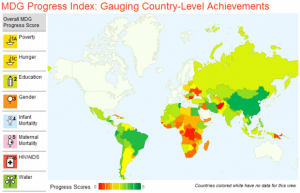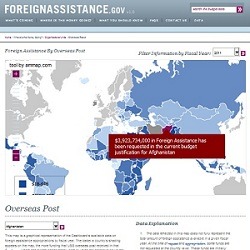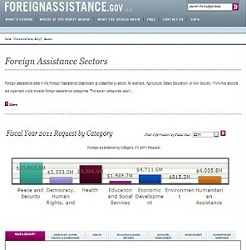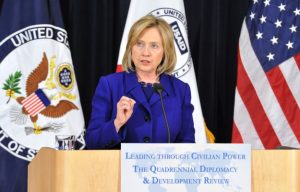Welcome to the January 2011 issue of the Global Washington newsletter. If you would like to contact us directly, please email us.
IN THIS ISSUE
Note from our Executive Director

Greetings,
Happy new year to all of you.
I want to thank you all for your support in 2010. We achieved many important milestones in 2010 by building national visibility and recognition for all of our work here in Washington State . As a hub of diverse and active international development players, the state of Washington is creating a model for collaboration in the global development sector, providing innovative strategies and cross-sector, cross-issue partnerships to build a better world.
Global Washington will build on this success by continuing to convene our members and friends, offering workshops that can build the capacity of your organization, and advocating on behalf of your work and on behalf of Washington State.
Our goal is to deepen our work by focusing on some specific sectoral work in 2011. We have started with international education and convened a working group of representatives from k-12 schools, private schools, academic institutions. organizations working to connect young people from the U.S. to the developing world, government, businesses and corporations, NGOs working on global education, and NGOs building schools in the developing world. Our goal is to organize this sector and build a shared strategy for global education that can be utilized by many institutions in our state. We will continue to bring you more information about this work in the coming months.
Once again, thanks so much for all of your support and we hope to see you at our upcoming events.
In unity,

Bookda Gheisar, Executive Director
Featured Organization: See Your Impact
 This past Christmas, I made two small donations to organizations helping seniors and children in need. How has the life of this elderly man changed because of the small gift card I bought to pay for his diabetic medicines? This was the question that flashed through my mind several times. I also tried to picture the little girl playing with the cooking toys I donated with a big smile on her face. SeeYourImpact definitely understands how small donors like me feel.
This past Christmas, I made two small donations to organizations helping seniors and children in need. How has the life of this elderly man changed because of the small gift card I bought to pay for his diabetic medicines? This was the question that flashed through my mind several times. I also tried to picture the little girl playing with the cooking toys I donated with a big smile on her face. SeeYourImpact definitely understands how small donors like me feel.
“Give a small gift, and in about 2 weeks, we’ll tell you exactly who you helped and how” is their model. SeeYourImpact’s mission is to “transform giving into a joyful and fulfilling experience for all donors by enabling charitable organizations to show the connection of each donor’s gift to the actual end beneficiary in an authentic and transparent manner.” Their vision is to “impact billions of lives, in virtually any cause area, anywhere in the world – one small gift at time.”
While millions of people have the capacity to give $25, they do not receive incentives for giving. SeeYourImpact identified this gap in the donor pyramid – small gifts from individual donors. By focusing on small tangible impacts, SeeYourImpact allows individual donors to see the results of their gifts in two weeks by providing the story captured at the point of interaction. Such fast turnaround requires well-trained on-the-ground staff and the support of stable and innovative technology. Seattle’s vibrant technology sector certainly facilitates this objective. SeeYourImpact leveraged innovative technology to build a platform, which personalizes each giving experience for small donors. As a result, these donors give more often. What also sets SeeYourImpact apart is that one hundred percent of the donations made by individual donors goes directly towards the gifts of choice by the donors themselves. On their website, donors can easily find a need to support. Some examples of their gift options are: $10 Mosquito Nets, $85 Wheelchairs, or $15 to give 50 children in Kenya the chance to see a doctor. Try it out for yourself by visiting their website: www.seeyourimpact.org. As a special incentive, a donor has offered to provide a $5 discount for the Global Washington community to be used towards any gifts on www.seeyourimpact.org , but hurry because it’s limited to the first 100 donors! Simply enter this code during the checkout process to receive your $5 discount: THUDN9LRWE.
 Besides donors and innovative technology, the success of SeeYourImpact also relies on partnering with proven and certified charities around the world to deliver gifts to individuals in need. To qualify as a partner, organizations must demonstrate integrity and passion in the work they do. Every SeeYourImpact partner must pass a rigorous selection process ensuring that scalable and sustainable impact is made to the people within their communities. The selection process includes certification by a trusted US-based non-profit organization and frequent site visits by SeeYourImpact staff. In addition, before each gift opportunity is listed on the SeeYourImpact website, a financial review of the organization and a detailed vetting of individual projects will be conducted to ensure that each gift fits the SeeYourImpact model. While very high standards are set for its partners, SeeYourImpact also ensures that each partner is well-supported by a SeeYourImpact regional office. Their first regional office was established in Mumbai, India for supporting local partners in India and Asia. Given their success, it is not surprising for SeeYourImpact to have a backlog of potential partners interested in their programs. As a result, it is in their plan to scale out regional offices in Latin America and Africa in the future.
Besides donors and innovative technology, the success of SeeYourImpact also relies on partnering with proven and certified charities around the world to deliver gifts to individuals in need. To qualify as a partner, organizations must demonstrate integrity and passion in the work they do. Every SeeYourImpact partner must pass a rigorous selection process ensuring that scalable and sustainable impact is made to the people within their communities. The selection process includes certification by a trusted US-based non-profit organization and frequent site visits by SeeYourImpact staff. In addition, before each gift opportunity is listed on the SeeYourImpact website, a financial review of the organization and a detailed vetting of individual projects will be conducted to ensure that each gift fits the SeeYourImpact model. While very high standards are set for its partners, SeeYourImpact also ensures that each partner is well-supported by a SeeYourImpact regional office. Their first regional office was established in Mumbai, India for supporting local partners in India and Asia. Given their success, it is not surprising for SeeYourImpact to have a backlog of potential partners interested in their programs. As a result, it is in their plan to scale out regional offices in Latin America and Africa in the future.
The lush international development community in Washington State also provides SeeYourImpact great opportunities to partner closely with nonprofit organizations and businesses in the region. When asked if SeeYourImpact has partnerships with other Global Washington members, Bradley Krugh, Director of Business Development, was able to quickly illustrate two success stories.
Esperanza International – Supporting Prolonged Dental Health of Children in Dominican Republic and Haiti
Esperanza International works to free children and their families from poverty through initiatives that work to generate income and promote education and health, restoring self-worth and dignity to those who have lost hope. As a certified organization of SeeYourImpact, the Esperanza International office oversees the distribution of donations given through SeeYourImpact to fund their work in the Dominican Republic and Haiti. With each $15 donation that Esperanza International received through SeeYourImpact, a child will receive a dental exam, as well as education on the importance of dental hygiene for both the child and their family. The child is also provided with the appropriate resources to ensure the prolonged good health of their teeth. A boy named Christopher in Dominican Republic now knows he must brush not only in the morning, but at night before bed if he wants to keep his teeth healthy and strong. Thanks to an individual donor, he can now share this simple but vital information with his friend while playing baseball, his favorite sport, in his community! For more stories reflecting the partnership between Esperanza International and SeeYourImpact go to: http://esperanza.seeyourimpact.org/
Rwanda Girls Initiative – Improving Girls’ English Skills
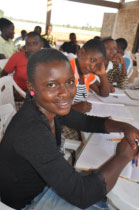 Another real story example of partnership is with Rwanda Girls Initiative, which educates and empowers girls in Rwanda to be the next generation of leaders in their communities and country. Starting in January 2011, Rwanda’s public school system is experiencing a drastic linguistic transformation – from French to English. English skills are critical to the passing of the secondary school entrance exam. However, space is very limited and competition is fierce. Rwandan girls, in particular, have a disadvantage given the current trend. Only 13% of Rwandan girls attend secondary school. Given all these challenges, if a Rwandan girl does not have the resources needed to improve her English skills, the chance for her to receive education beyond elementary school will be slim. Mary Josine is one of the lucky girls to receive education sponsorship from donors through SeeYourImpact. With just $40, the donor supports Mary Josine to attend a 12-week intensive English course on the weekends. The donation pays for the costs of English teachers, tutors, one composition book and other classroom materials. Through this program, Mary Josine is able to have the opportunity to work towards her dream of becoming a doctor!
Another real story example of partnership is with Rwanda Girls Initiative, which educates and empowers girls in Rwanda to be the next generation of leaders in their communities and country. Starting in January 2011, Rwanda’s public school system is experiencing a drastic linguistic transformation – from French to English. English skills are critical to the passing of the secondary school entrance exam. However, space is very limited and competition is fierce. Rwandan girls, in particular, have a disadvantage given the current trend. Only 13% of Rwandan girls attend secondary school. Given all these challenges, if a Rwandan girl does not have the resources needed to improve her English skills, the chance for her to receive education beyond elementary school will be slim. Mary Josine is one of the lucky girls to receive education sponsorship from donors through SeeYourImpact. With just $40, the donor supports Mary Josine to attend a 12-week intensive English course on the weekends. The donation pays for the costs of English teachers, tutors, one composition book and other classroom materials. Through this program, Mary Josine is able to have the opportunity to work towards her dream of becoming a doctor!
You may access more stories about the impact of Rwanda Girls Initiative’s and SeeYourImpact’s partnership at: http://rgi.seeyourimpact.org/
Partnership with Esperanza International and the Rwanda Girls Initiative are only a couple of examples of how SeeYourImpact reciprocates support from the global development community of Washington State. SeeYourImpact also receives support from local philanthropists, like Apolo Ohno, eight-time Olympic medalist and one of CNN 2010 Blue Ribbon Panelists. He calls SeeYourImpact the “future of philanthropy”. To find out why Apolo Ohno said “partnering with SeeYourImpact is what life is all about”, visit this CNN video link: http://www.cnn.com/2010/LIVING/10/20/cnnheroes.apolo.anton.ohno/
Next time when I make small donations, I know that meeting the lives I changed is possible!
To learn more about SeeYourImpact and their partners, and to meet the life you can change, please visit www.seeyourimpact.org. Don’t forget the $5 discount code: THUDN9LRWE.
*Photos courtesy of SeeYourImpact.
Back to Top
Changemaker: Mark Schlansky and Uplift International
 “The most wonderful moment I ever had working in international development was in a madrasah in Indonesia,” said Mark Schlansky, founder and CEO of Uplift International. Mark was visiting one of the many schools participating in Uplift International’s School Health & Nutrition Program, which benefits some of the poorest children in the country. Two days earlier, Barack Obama had been elected president of the United States and many Indonesians were aglow. “He lived in Indonesia for four years as a child and so they view him as one of their own,” Mark explained. “It was a big event for them – us too.” Before the scheduled cooking demonstration, the head of the school mentioned the election, saying “Look at that! If an African-American can become president, then kids like you can grow up to become a president. I want you all to remember this lesson and pay particular attention to what you can learn about health and nutrition so that one day you can grow up to be a president too.” This was an empowering statement for children who had grown up with very limited possibilities. “The message was delivered and the children responded with great enthusiasm,” Mark reflected. “It gave me goose bumps!”
“The most wonderful moment I ever had working in international development was in a madrasah in Indonesia,” said Mark Schlansky, founder and CEO of Uplift International. Mark was visiting one of the many schools participating in Uplift International’s School Health & Nutrition Program, which benefits some of the poorest children in the country. Two days earlier, Barack Obama had been elected president of the United States and many Indonesians were aglow. “He lived in Indonesia for four years as a child and so they view him as one of their own,” Mark explained. “It was a big event for them – us too.” Before the scheduled cooking demonstration, the head of the school mentioned the election, saying “Look at that! If an African-American can become president, then kids like you can grow up to become a president. I want you all to remember this lesson and pay particular attention to what you can learn about health and nutrition so that one day you can grow up to be a president too.” This was an empowering statement for children who had grown up with very limited possibilities. “The message was delivered and the children responded with great enthusiasm,” Mark reflected. “It gave me goose bumps!”
That moment epitomizes what Uplift International is all about: educating and empowering people to advocate for their rights, which enables them to achieve a better future. Uplift’s focus is on health; their activities include health education, women’s health, policy analysis and NGO advocacy training. The Uplift approach is grounded in justice, ethics, and human rights and goes beyond the traditional biomedical model.
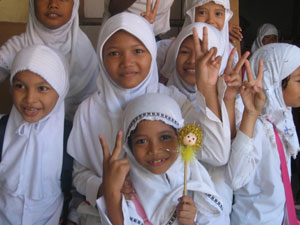 When asked if he was always interested in humanitarian work, Mark responded, “no it found me.” In 1995, he was working as an executive at McDonnell Douglas (which later merged with Boeing) in international government affairs in Washington, DC. He received a request from a U.S. Senator, on behalf of a constituent, asking if he could find an airplane for a humanitarian aid shipment to Vietnam at no cost. At the time, he was looking at Vietnam as a potential emerging market for commercial aircraft. The request resonated with opportunity – introducing both the company and an airline customer to an emerging market, while providing much needed aid to the people of Vietnam. However, there were many obstacles to overcome. The U.S. and Vietnam did not have diplomatic relations in 1994. He needed to convince the company that this idea was a good strategic business decision — a way into a new market and a means of “doing good,” as well. He also needed the approval to find a customer airline to provide donated transport for the cargo. The initiative would go nowhere without the cooperation of the governments of The United States and Vietnam.
When asked if he was always interested in humanitarian work, Mark responded, “no it found me.” In 1995, he was working as an executive at McDonnell Douglas (which later merged with Boeing) in international government affairs in Washington, DC. He received a request from a U.S. Senator, on behalf of a constituent, asking if he could find an airplane for a humanitarian aid shipment to Vietnam at no cost. At the time, he was looking at Vietnam as a potential emerging market for commercial aircraft. The request resonated with opportunity – introducing both the company and an airline customer to an emerging market, while providing much needed aid to the people of Vietnam. However, there were many obstacles to overcome. The U.S. and Vietnam did not have diplomatic relations in 1994. He needed to convince the company that this idea was a good strategic business decision — a way into a new market and a means of “doing good,” as well. He also needed the approval to find a customer airline to provide donated transport for the cargo. The initiative would go nowhere without the cooperation of the governments of The United States and Vietnam.
In April of 1995, on the twentieth anniversary of the end of the war in Vietnam, Mark stood on the tarmac at the airport in Hanoi and watched a FedEx cargo plane land and taxi in to unload medicines and medical supplies destined to be used in public hospitals for Vietnam’s most vulnerable people. It was then he realized that a great deal can be done to improve the health of vulnerable people around the world—and he could be part of it by utilizing the skills he developed as an executive and applying them to improve health in developing countries.
“In six phone calls, my life was transformed,” Mark said in reflecting back to what it took to make this opportunity work. He realized that business sense and contacts could be used to do even more compelling work in health. He was hooked. By 1997, after working on some other small health projects in Vietnam, he founded Uplift International, a nonprofit organization that would develop sustainable health programs in Southeast Asia. “Working in Vietnam on health projects made me realize a lot more about the world. Everyone has a right to health, which is fundamental to any development work,” he said.
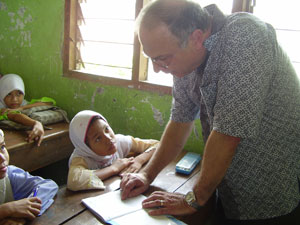 The right to health is central to all of Uplift’s programs. They provide a school health and nutrition curriculum in primary level madrasahs (Islamic religious schools) that are attended by the poorest children, as their families cannot afford the fees charged by public schools. The program provides nutritious breakfast, as well as health and health education to the students. Uplift trains teachers to teach the curriculum to students in an age-appropriate way. Children and parents learn about healthy living and how to exercise their right to healthcare with the government. Uplift also works with local NGOs on women’s health issues, providing tools to analyze policy and law and helping them develop evidence-based arguments and advocacy plans based on a human rights approach. The goal is to make government budgets more equitable and transparent and to ensure that resources are allocated to the areas that are most needed, particularly towards often-overlooked women’s health issues. They have also used rights-based approaches on programs designed to end violence against women. The organization has also brought millions of dollars in medicines and medical supplies to survivors of natural disasters in Vietnam, Indonesia and Myanmar. Mark has tapped into his aviation contacts to obtain free transport of medicines and supplies for humanitarian aid.
The right to health is central to all of Uplift’s programs. They provide a school health and nutrition curriculum in primary level madrasahs (Islamic religious schools) that are attended by the poorest children, as their families cannot afford the fees charged by public schools. The program provides nutritious breakfast, as well as health and health education to the students. Uplift trains teachers to teach the curriculum to students in an age-appropriate way. Children and parents learn about healthy living and how to exercise their right to healthcare with the government. Uplift also works with local NGOs on women’s health issues, providing tools to analyze policy and law and helping them develop evidence-based arguments and advocacy plans based on a human rights approach. The goal is to make government budgets more equitable and transparent and to ensure that resources are allocated to the areas that are most needed, particularly towards often-overlooked women’s health issues. They have also used rights-based approaches on programs designed to end violence against women. The organization has also brought millions of dollars in medicines and medical supplies to survivors of natural disasters in Vietnam, Indonesia and Myanmar. Mark has tapped into his aviation contacts to obtain free transport of medicines and supplies for humanitarian aid.
Beyond the local impact in Indonesia as a result of the programs, Uplift sees results on the national level as well. The organization sponsored the first national conference on health and human rights in Indonesia in 2003. This impacted the government’s push to incorporate human rights and bioethics into the national curriculum for first-year medical students. Uplift also has an influence here in the state of Washington through Mark’s wife, Beth E. Rivin, MD, MPH. Beth is a Research Associate Professor of Law at the University of Washington and is the Director of the Global Health and Justice Program. She is also Vice President of Programs at Uplift. Her influence helped create The International Research Ethics Fellowship Program funded by the National Institutes of Heath at the University of Washington for Indonesian doctors to come and study at UW. Beth’s UW affiliation has also enabled students to work in Indonesia with Uplift to broaden their experience. Mark and Beth hope to continue developing partnerships and sharing Uplift’s rights-based approach with other organizations to bring a justice component to health programs. This approach identifies the most vulnerable and provides a mechanism to advocate for equity for all. In other words, a rights-based approach creates the greatest impact. Mark believes that focusing on justice, ethics, and human rights is central to success in global health because it creates an enabling environment for all other medical and public health interventions. Uplift International starts at the bottom, providing healthcare information on a local level, giving people access to services, and teaching them about their rights. As Mark said, at the end of the day, “justice is what it’s all about.”
Back to Top
Announcements
Global Washington is moving downtown!
We’re saying goodbye to our University District office and moving to the Logan Building on 5th Avenue and Union Street in downtown Seattle. We are looking forward to having a larger office with more stations for volunteers, better access to public transportation, and our very own conference room to host events. We will continue to share office space with the Seattle International Foundation and would like to thank them for all their help in coordinating our move. We would also like to thank InterConnection for donating seven computers for our volunteer stations!
As of January 31st, our mailing and physical address will be:
500 Union St., Suite 801
Seattle, WA 98101
Our phone numbers will not change.
Labors of Love: People Changing the World — Shoreline Community College Hosts Symposium in February
The Global Affairs Center at Shoreline Community College is hosting a Humanitarian Assistance Symposium from February 2-24. The Symposium will feature four evening and five daytime presentations with 11 private aid organizations, including World Concern, Global Partnerships, Global Washington and others. Sessions will address the following questions: What role do individuals and non-government organizations (NGOs) play in the delivery of emergency and development assistance overseas? How are their efforts coordinated with those of national governments and international organizations? Learn, be inspired, and get involved. For details about speakers, dates and locations, go to http://www.shoreline.edu/gac/hum_assistance_2011.aspx.
Recruit Interns Through Shoreline Community College’s Virtual Engagement Fair
As part of its symposium on international humanitarian assistance, Shoreline Community College invites you to participate in an opportunity to promote the work of your organization and recruit volunteers and/or interns among students at Shoreline Community College.
SCC is organizing a “virtual engagement fair” where students can find out more about opportunities for volunteering and/or interning with specific organizations. It works like this:
- You provide a website address for information about your organization’s work and about opportunities for volunteering and/or internships.
- You provide the name(s) and email address(es) of (a) specific individual(s) available during the month of February to respond to student queries.
- The name of your organization, along with the name(s) of contacts, website and email address, and any volunteer or internship opportunities (optional) will be posted on our “virtual bulletin board” and students encouraged are to contact your office.
If you would like to participate in this online fair, or for more information, please contact Larry Fuell, Director of the Global Affairs Center at SCC (lfuell@shoreline.edu) as soon as possible.
List your events on the Global Washington calendar
We would like to call your attention to the events calendar on our website, which highlights events that might be of interest to the global development sector in Washington. We want our calendar to be the web’s most comprehensive listing of global development events in the state.
We are now allowing our members to post and make changes to their own events in the calendar. This will help ensure that events are listed in a timely manner and that all information is accurate and up-to-date. If you’d like to find out how to post to our calendar, please email admin@globalwa.org.
Non-members with events of interest to the global development sector can send an invitation or press release to admin@globalwa.org and we will review it for inclusion in the calendar.
World Affairs Council hosts event with Ronald E. Neuman, President of the American Academy of Diplomacy
On February 16th, the World Affairs Council is hosting “The State Department & USAID: The Broken Civilian Component of National Security” with Ronald E. Neumann, President of the American Academy of Diplomacy. Newman will discuss why the United States must partner its military capabilities with the smart power of diplomacy and aid. Twenty years of systematically hollowing out USAID and the State Department have left civilian diplomatic and aid workers unable to meet their responsibilities and have led to an increasing militarization of our foreign policy. Ambassador Neumann will describe the problem and what needs to be done from the perspective of his service in four wars and 37 years of diplomacy.
The event costs $15 for non-members and $10 for members and students and will take place at the University of Washington in Kane Hall 110. Registration is at 6:30. There is also a networking reception prior to the event. For more details or to sign up, please visit http://www.world-affairs.org/calendar.cfm?eventID=1380&action=eventDetails.
Registration open for the 2011 Pacific NW Global Donors Conference
Local philanthropists and grantmakers should not miss the 2011 Pacific NW Global Donors Conference, which will take place April 1st and 2nd in Seattle. The theme of this year’s conference is “Giving for Sustainable Change.” It will provide education on many of today’s most significant global issues (including agriculture, climate justice, human rights and more!), explore best practices in international grantmaking, and—most importantly—will connect you with the growing community of global philanthropists in the Pacific NW. One of the keynote speakers will be entrepreneur, human rights activist, and philanthropist, Greg Carr, who is leading a bold philanthropic venture to restore Mozambique’s Gorongosa National Park.
To register or find descriptions of more of the conference sessions, http://www.globaldonorsconference.org/. Early bird registration ends on February 28th.
Global Washington is Hiring!
Global Washington is seeking a Membership and Program Coordinator to support and recruit members and to develop quality programming. This person should be a self-starter with excellent communication and inter-personal skills. This position will represent Global Washington within the community and applicant should have experience in event planning and coordination be comfortable with public relations. Familiarity with the Global Development sector is a must, as this position will be responsible for identifying and supporting member needs and helping develop programs that best meet those needs.
Visit our website for a full description of this position.
For questions or to apply, send a cover letter and resume to admin@globalwa.org.
Friends of the Orphans – Remembering Haiti
Friends of the Orphans promoted two events this month in support of Nuestros Pequenos Hermanos/Nos Petit Freres et Souers, a network of homes in Latin America and the Caribbean that cares for disadvantaged children. Since the earthquake NPH/NPFS has greatly expanded its programming in Haiti in order to care for the many children who were displaced or orphaned by the disaster. On January 12th, there was an evening of prayer and remembrance, with pictures and updates about the progress made in Haiti in the aftermath of the devastating earthquake last year. On January 19th, Friends of the Orphans hosted “Hope and Healing in Haiti” to raise money for NPH/NPFS and their continued work in the country.
Ayni Education International Seeks Executive Director
Ayni Education International is a small, impactful, Seattle-based international NGO that builds and equips schools in Afghanistan, strengthens the Afghan education system, and builds bridges of understanding between our countries. It seeks to hire an entrepreneurial and self-directed Executive Director to develop, implement and expand its projects in Afghanistan and the U.S. The applicant must have experience in organizational leadership, international project management, fundraising and working in the developing world, excellent communication skills, and a willingness to travel to Afghanistan. Preference will be given to those with a master’s degree or its equivalence in international development, preferably in education. Relocation fees are not available. Resumes should be sent to info@aynieducation.org.
Donate Computers to InterConnection & Global Washington
InterConnection.org is donating computers to Global Washington. Now we would like you to help us donate computers to InterConnection!
InterConnection.org obtains used laptops and desktops from companies and individuals, refurbishes them and puts them in the hands of people in need. They create opportunity through computer reuse–from their Seattle-based computer repair vocational program to non-profits and organizations far and wide.
If you have an old desktop or laptop that you no longer use, just bring it to their facility and mention that your computer should be credited towards Global Washington. If your business has three or more computers, InterConnection will pick them for free! InterConnection’s address and contact details are at www.interconnection.org. If you have a laptop you can mail it to InterConnection for free– they will email you a prepaid shipping label. Just fill out the form here: www.interconnection.org/give_mail.html Include a note with the laptop that says it is for Global Washington.
Fellowships for Social Justice Leaders through the Petra Foundation
The Petra Foundation seeks out and champions unsung leaders who are making distinctive contributions to the rights, autonomy, and dignity of millions who are marginalized in America. Each year grassroots leaders selected as Petra Fellows receive a no-strings personal financial award. In addition, the Foundation publicizes their innovative models for change, fosters their collaborations, and welcomes them to a national network of leaders who are working across the divides of age, ethnicity, class, and issue to build a more just society. Nominees should display a combination of activism and thought, force of character, independence of judgment, and clarity of expression. Nominations should be submitted by those who know the nominees and their work (without the knowledge of the nominees). The deadline for submitting nominations is February 11, 2011. Visit the Foundation’s website at http://www.petrafoundation.org/nominate.html to learn more about the program and the nomination process.
Register for The Global Health and Innovation Conference
The 8th Annual Global Health and Innovation Conference, presented by Unite for Sight, will take place at Yale University on April 16th and 17th. The conference will convene 2,200 leaders, changemakers, and participants from all fields of global health, international development, and social entrepreneurship from all 50 states and from 50 countries. Confirmed keynote speakers include
- “Pharmaceuticals For Humanity,” Victoria Hale, PhD, Founder of Medicines360; Founder and Chair Emeritus, OneWorld Health
- Jeffrey Sachs, PhD, Director of Earth Institute at Columbia University; Quetelet Professor of Sustainable Development, Professor of Health Policy and Management, Columbia University; Special Advisor to Secretary-General of the United Nations Ban Ki-moon
- Sonia Ehrlich Sachs, MD, MPH, Director of Health, Millennium Village Project, Earth Institute at Columbia University
For more details visit the conference website at http://www.uniteforsight.org/conference/. Register by the end of January to receive the lowest price. If you are interested in presenting at the conference, submit your social enterprise pitches. Guidelines are available at http://www.uniteforsight.org/conference/social-enterprise-pitch
SeeYourImpact’s Special Offer for the Global Washington Community
Are you looking for a meaningful gift to give to those in need around the world? Would you like to know exactly who you helped and how? SeeYourImpact is an organization that can help you achieve both goals. SeeYourImpact’s mission is to “transform giving into a joyful and fulfilling experience for all donors by enabling charitable organizations to show the connection of each donor’s gift to the actual end beneficiary in an authentic and transparent manner.” Once you have picked a gift of your choice on the SeeYourImpact website, in about 2 weeks, they will tell you exactly who you helped and how your gift has changed the beneficiary’s life.
As a special incentive, a donor has offered through SeeYourImpact to provide a $5 discount for the Global Washington community towards any gift options—but hurry because it’s limited to the first 100 donors! While the special offer lasts, try it for yourself and meet the life you changed! Simply visit www.seeyourimpact.org and enter this code during the checkout process to receive your $5 discount: THUDN9LRWE
“Classroom on the World” Series Will Feature South Africa in February
On February 8th, the World Affairs Council Tacoma and Bates Technical College are presenting, “South Africa: Transition to Democracy Through Reconciliation” as part of the “Classroom on the World” series. This session will feature Neal Sobania, Executive Director of the Wang Center for Global Education and Professor of History at Pacific Lutheran University. The workshop is designed to provide teachers with background to understand the history of how apartheid came to exist in South Africa and materials to use in providing this background to their students. It will also address the role that Archbishop Desmond Tutu, the 1984 Nobel Peace Prize recipient, has played in mediating South Africa’s transition to democracy and modeling what a vibrant, peaceful community should be.
The event will take place in the Bates Technical College Auditorium from 4:00pm to 7:00pm. The cost is $20.00, which includes three clock hours, teaching resources, and a buffet dinner. To register, visit www.wactacoma.com.
InterAction Releases 2011 Foreign Assistance Briefing Book
InterAction just announced the release of its second biennial Foreign Assistance Briefing Book (FABB). The book covers 16 critical topics, from climate change to agricultural development and health, as well as countries deemed important to U.S. national interests, including Afghanistan. InterAction’s alliance of member organizations worked together to develop succinct yet informative policy papers, compiled by the best thinkers in the community, drawing from expertise and lessons learned from working in the developing world. The 2011 FABB presents the unified voice of the U.S. NGO community on foreign policy issues expected to draw attention in the 112th Congress. Browse the comprehensive FABB online by visiting www.interaction.org/fabb.
Submit Papers for the IEEE Global Humanitarian Technology Conference
The IEEE Global Humanitarian Technology Conference 2011 will take place October 30 – November 1st. The Conference Organizing Committee invites you to participate in the program! GHTC 2011 is the first annual conference designed to gather together scientists, engineers, technology professionals, academics, foundations, government and non-government organizations, and individuals engaged in humanitarian work to discuss and develop solutions for present and future humanitarian needs. Participation in GHTC 2011 is open to all technologists or organizations interested in applying technology to humanitarian goals and to non-technical individuals and organizations interested in learning about the application of technology to humanitarian challenges.
Following the Conference theme of “Technology for the benefit of humanity”, topics include but are not limited to:
- Health, Medical Technology and Telemedicine
- Disaster Warning/Response
- Water Planning, Availability and Quality
- Power for Off-Grid Users
- Power Infrastructure/ Renewable/Sustainable Energy
- Connectivity and Communications Technologies (data/voice) for Remote Locations
- Educational Technologies
- Agricultural Technologies
The deadline for submissions is March 11, 2011. For submission guidelines and more information on the conference, please visit: http://www.ieeeghtc.org/.
Back to Top
Global Washington Events:
Friday, February 4
Utilizing Social Media in the Nonprofit Sector
Wednesday, February 16
Getting Started with Social Media: An Introductory Course– Session 1
Wednesday, February 23
Getting Started with Social Media: An Introductory Course – Session 2
Back to Top
General Events:
Wednesday, February 2
Symposium on Humanitarian Assistance – Julia Bolz
Tuesday, February 8 – Friday, February 11
iConference 2011
Tuesday, February 8
Classroom on the World – South Africa, Transition to Democracy through Reconciliation
Wednesday, February 9
Symposium on Humanitarian Assistance – David Eller, President, World Concern
Thursday, February 10
Symposium on Humanitarian Assistance – Charles Brennick, Interconnection
Wednesday, February 16
Symposium on Humanitarian Assistance – Bookda Gheisar, Global Washington
World Affairs Council hosts The State Department & USAID: The Broken Civilian Component of National Security
Symposium on Humanitarian Assistance – Jacqueline Sherris, PATH
Thursday, February 17
Symposium on Humanitarian Assistance – Cindy Nofzinger, Schools for Salone
Wednesday, February 23
Community Coffee with PATH
Symposium on Humanitarian Assistance – Chris Megargee, Global Partnerships
Symposium on Humanitarian Assistance – Bolivia Smiles Forever (open to dental professionals and dental hygiene students)
Symposium on Humanitarian Assistance – Diana Fletschner, Landesa (Rural Development Institute)
Thursday, February 24
Symposium on Humanitarian Assistance – Student-led NGOs
Monday, February 28
World Affairs Council hosts Tim Johnson author of “Tragedy in Crimson: How the Dalai Lama Conquered the World but Lost the Battle with China”
Thursday, March 3
World Affairs Council presents The Wrong War: Grit, Strategy, and the Way Out of Afghanistan
Tuesday, March 22
Habitat for Humanity – Building Houses, Building Hope Breakfast
Back to Top
A Review of Enhancing U.S. Education and Competiveness
an article in Foreign Affairs by Arne Duncan
Review by Linda Martin, guest blogger
In Enhancing U.S. Education and Competiveness, an article which appears in the November/December 2010 issue of Foreign Affairs, U.S. Secretary of Education Arne Duncan links U.S. economic competitiveness directly to the American educational system. The news is sobering. U.S. competiveness is sliding. The causes− low educational performance of U.S. students; teaching systems that fail to deliver on preparing students for 21st century employment; and protectionist attitudes towards international educational investment.
| “The nation that out-educates us today is going to out-compete us tomorrow.”– President Barak Obama |
Through eye-opening statistics, Duncan demonstrates how the problem starts early in the education cycle and continues through college. By the end of 2010, “the portion of U.S jobs demanding a postsecondary education will be 63%” and the discrepancy between supply and demand is growing. Georgetown University’s Center on Education and the Workforce estimates that the United States will be short 3 million college graduates by 2018. According to Duncan, potential solutions include:
- Implementing reforms, including STEM (Science, Technology and Math) programs; new Pell Grants and new K-12 competency standards.
- Upgrading language requirements, expanding multicultural learning opportunities and offering incentives to boost the number of teachers in foreign languages fields;
- Channeling spending toward the most challenged students;
- Relinquishing protectionist views towards international education, and embracing an ethic in which “advancing education everywhere brings benefits to everyone.”
- Supporting new technology based knowledge delivery systems; and higher quality teacher training.
Duncan paints the picture of a U.S. economy with growing needs for an educated workforce, and an education system that is not keeping pace. Technology has dramatically increased the demand for skilled college graduates, who compete worldwide for positions in the global marketplace. Yet in one generation, “the U.S. has fallen from first to fifth position among developed countries with the most college graduates, and ranks ninth in college completion rates among 25 to 34 year olds”.
In an unprecedented effort, the U.S. government is investing $3.7 billion in STEM (Science, Technology and Math) programs, including $1 billion for K-12 initiatives. Yet research has shown that money alone will not suffice. “With the exception of Luxembourg, the United States spends more per elementary student than any other Organization for Economic Co-operation and Development (OECD) nation.” At the secondary level, only 3 countries spend more per student, and no other country spends as much as the U.S., at the college level.
Developed nations with higher educational performance rates than the U.S. target their resources to students with the most need. In the United States, however, school funding often depends on tax levies that reflect the affluence of local communities. Duncan quotes an observation by Dennis Van Roekel, the president of the National Education Association, that “other developed nations are more successful at recruiting talented teachers, providing first-rate teaching preparation and professional development, and honoring the teaching profession. Unlike in the United States, in South Korea teachers come from the top ten percent of graduates — and those who teach are viewed as making an important contribution to building their nation”.
Duncan makes the point that investments in STEM, while laudable, need to be balanced with investments in other areas. Employers lament the inability of the educational system to cultivate the skills they want – “the ability to adapt, innovate, synthesize data, communicate effectively, learn independently, and work in teams.” New and expanded initiatives in multi-cultural learning, language acquisition, and the arts and humanities, can provide a more fertile ground for building the combination of intellectual, creative, humanistic, and professional skills needed to compete and collaborate in the 21st century.
| If you talk to a man in a language he understands,” that goes to his head. If you talk to him in his language that goes to his heart.”– Nelson Mandela |
The dilemma the U.S. faces in foreign language acquisition exemplifies the systemic nature of the problem. Elementary school is a time where language is perhaps easiest to learn, yet only 1 in 4 schools offer foreign language studies. At the secondary level, according to Duncan, “only 10 U.S. states have foreign language requirements in order to graduate, while 75 % of states have reported shortages in foreign-language teachers (2007-08 figures)”. Without exposure to other cultures and languages, what motivation do students have to consider teaching language as a profession, or to consider other occupations where the ability to communicate with colleagues from diverse cultural backgrounds is critical? Duncan points out, “In 2002, just months after 9/11, U.S. postsecondary institutions nationwide awarded only six bachelor’s degrees in Arabic language and literature. By 2008, the total had risen only to 57”.
One thing we can all do that does not require money or other resources, is to realize that “expanding educational attainment everywhere is the best way to grow the pie for all”. Better-educated populations abroad mean greater markets for U.S. goods; a globally educated population can better meet challenges that the U.S. cannot achieve alone; research confirms that a better educated world is a less violent world; and well-educated immigrants help our economy. Per writer Ben Wildavsky, “from 1995 to 2005, immigrants started one-fourth of all engineering and technology companies in the U.S.”
Along with our global competitors, we can gain from sharing best practices. For example, the American traditions of free inquiry and peer-reviewed research are held in esteem by many countries, and we are unrivaled in providing educational access to students of all socioeconomic levels.
Given American innovation in the field of technology, we can choose to take a leadership role in expanding educational access globally while responding to new U.S. student demographics. We can do this by combining successful classroom based experiences with “technology-rich learning environments, online classes, distance learning, and electronic instruction.”
Improving the U.S. educational system, and in so doing so, the U.S. economy, requires a strong and serious commitment at all levels of the U.S. government, partnerships with the private sector and community activism. It requires collaboration with other nations and sharing of best practices, to the benefit of all concerned. Success depends on a new mindset of mutual and shared progress; a stronger valuing of the teaching profession and higher quality teacher training; new ways to deliver knowledge; and a balanced investment at all levels of education. Working together, schools can cultivate the skills employers want and the world needs to solve global problems. Duncan delivers a thorough analysis of the challenges and the solutions that can help the U.S. restore its educational capital, and establish itself as 21st century world leader in educational innovation.
*according to a study from the National Bureau of Economic Research, China







